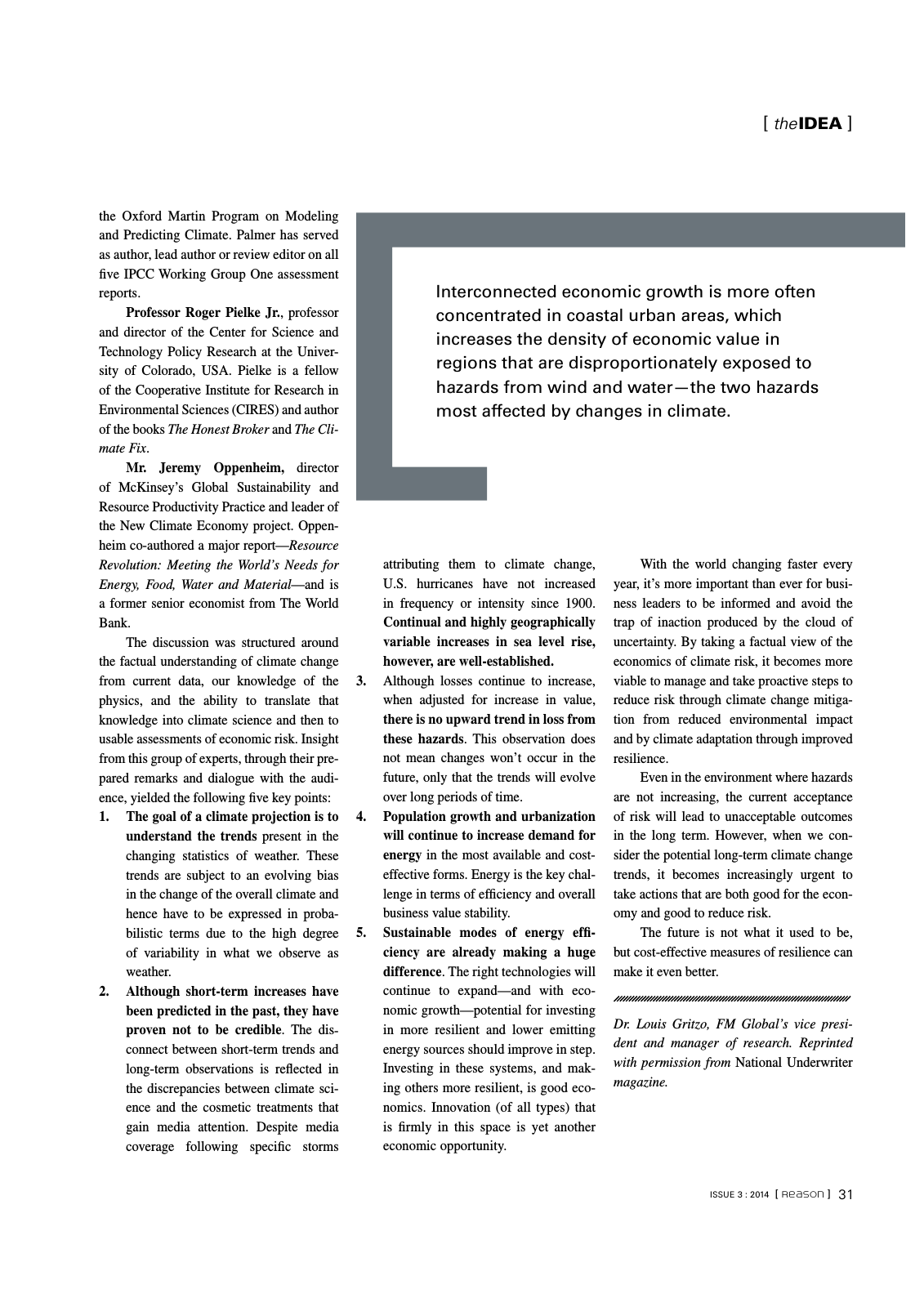Reason Magazin 2014Q3 Seite 31
Hinweis: Dies ist eine maschinenlesbare No-Flash Ansicht.Klicken Sie hier um zur Online-Version zu gelangen.
Inhalt
the Oxford Martin Program on Modeling and Predicting Climate Palmer has served as author lead author or review editor on all five IPCC Working Group One assessment reports Professor Roger Pielke Jr professor and director of the Center for Science and Technology Policy Research at the Univer sity of Colorado USA Pielke is a fellow of the Cooperative Institute for Research in Environmental Sciences CIRES and author of the books The Honest Broker and The Cli mate Fix Mr Jeremy Oppenheim director of McKinsey s Global Sustainability and Resource Productivity Practice and leader of the New Climate Economy project Oppen heim co authored a major report Resource Revolution Meeting the World s Needs for Energy Food Water and Material and is a former senior economist from The World Bank The discussion was structured around the factual understanding of climate change from current data our knowledge of the physics and the ability to translate that knowledge into climate science and then to usable assessments of economic risk Insight from this group of experts through their pre pared remarks and dialogue with the audi ence yielded the following five key points 1 The goal of a climate projection is to understand the trends present in the changing statistics of weather These trends are subject to an evolving bias in the change of the overall climate and hence have to be expressed in proba bilistic terms due to the high degree of variability in what we observe as weather 2 Although short term increases have been predicted in the past they have proven not to be credible The dis connect between short term trends and long term observations is reflected in the discrepancies between climate sci ence and the cosmetic treatments that gain media attention Despite media coverage following specific storms attributing them to climate change U S hurricanes have not increased in frequency or intensity since 1900 Continual and highly geographically variable increases in sea level rise however are well established 3 Although losses continue to increase when adjusted for increase in value there is no upward trend in loss from these hazards This observation does not mean changes won t occur in the future only that the trends will evolve over long periods of time 4 Population growth and urbanization will continue to increase demand for energy in the most available and cost effective forms Energy is the key chal lenge in terms of efficiency and overall business value stability 5 Sustainable modes of energy effi ciency are already making a huge difference The right technologies will continue to expand and with eco nomic growth potential for investing in more resilient and lower emitting energy sources should improve in step Investing in these systems and mak ing others more resilient is good eco nomics Innovation of all types that is firmly in this space is yet another economic opportunity With the world changing faster every year it s more important than ever for busi ness leaders to be informed and avoid the trap of inaction produced by the cloud of uncertainty By taking a factual view of the economics of climate risk it becomes more viable to manage and take proactive steps to reduce risk through climate change mitiga tion from reduced environmental impact and by climate adaptation through improved resilience Even in the environment where hazards are not increasing the current acceptance of risk will lead to unacceptable outcomes in the long term However when we con sider the potential long term climate change trends it becomes increasingly urgent to take actions that are both good for the econ omy and good to reduce risk The future is not what it used to be but cost effective measures of resilience can make it even better Interconnected economic growth is more often concentrated in coastal urban areas which increases the density of economic value in regions that are disproportionately exposed to hazards from wind and water the two hazards most affected by changes in climate Dr Louis Gritzo FM Global s vice presi dent and manager of research Reprinted with permission from National Underwriter magazine the IDEA ISSUE 3 2014 Reason 31
